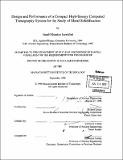| dc.contributor.advisor | Richard Lanza. | en_US |
| dc.contributor.author | Jureidini, Imad Maurice | en_US |
| dc.date.accessioned | 2010-01-07T20:50:06Z | |
| dc.date.available | 2010-01-07T20:50:06Z | |
| dc.date.copyright | 1998 | en_US |
| dc.date.issued | 1998 | en_US |
| dc.identifier.uri | http://hdl.handle.net/1721.1/50534 | |
| dc.description | Thesis (Ph.D.)--Massachusetts Institute of Technology, Dept. of Nuclear Engineering, 1998. | en_US |
| dc.description | Includes bibliographical references (p. 137-138). | en_US |
| dc.description.abstract | The aim of this work is to study the feasibility of a computed tomography (CT) sensor useful to the metal casting industry to improve product quality and productivity. X-ray CT allows the non-destructive measurement of the two-dimensional density distribution in a given plane through an object. The solid and liquid phases of aluminum differ in density by approximately 10%, allowing CT to discriminate the solidification front. A compact high-energy x-ray CT system was designed and built to observe the solidification front in an aluminum sample 15-cm in diameter. X-rays photons were produced by a compact 6 MeV linear accelerator (linac) with an average energy of 1.3 MeV. The linac was pulsed at a rate of 180 Hz, with a 4 Rs pulse duration. The photons were emitted from a 2-mm spot in a 320 fan-beam configuration. A 128-channel detector system, placed on an arc 84.5 cm away from the source, performed x-ray attenuation measurements. Channels consisted of 1.8 mm wide cadmium tungstate scintillation crystals coupled to photodiodes. Tungsten anti-scatter plates were used to reduce the influence of scattered photons on the signal. The imaged object was placed on a motion system in order to perform the 3600 rotation necessary for tomographic reconstruction. The system achieved a resolution of 1.6 mm with a slice thickness of 5 mm and a sensitivity of 1.5 %. Data acquisition time was 2 minutes, but was limited by the maximum speed of the rotary stage. The solidification front in a pure aluminum sample was successfully imaged. A study of the feasibility of identifying the solidification front in a metal cast using measurements obtained by translation alone is presented. A model-based reconstruction algorithm was implemented assuming a rectangular liquid zone surrounded by a rectangular solid zone. A sample object's geometry was correctly reconstructed from experimental data, demonstrating promise for this technique. An analysis of its theoretical performance is presented in terms of the experimental parameters. | e n_US |
| dc.description.statementofresponsibility | by Imad Maurice Jureidini. | en_US |
| dc.format.extent | 138 p. | en_US |
| dc.language.iso | eng | en_US |
| dc.publisher | Massachusetts Institute of Technology | en_US |
| dc.rights | M.I.T. theses are protected by
copyright. They may be viewed from this source for any purpose, but
reproduction or distribution in any format is prohibited without written
permission. See provided URL for inquiries about permission. | en_US |
| dc.rights.uri | http://dspace.mit.edu/handle/1721.1/7582 | en_US |
| dc.subject | Nuclear Engineering | en_US |
| dc.title | Design and performance of a compact high-energy computed tomography system for the study of metal solidification | en_US |
| dc.type | Thesis | en_US |
| dc.description.degree | Ph.D. | en_US |
| dc.contributor.department | Massachusetts Institute of Technology. Department of Nuclear Science and Engineering | en_US |
| dc.identifier.oclc | 43080419 | en_US |
